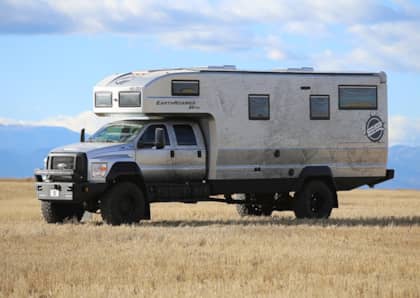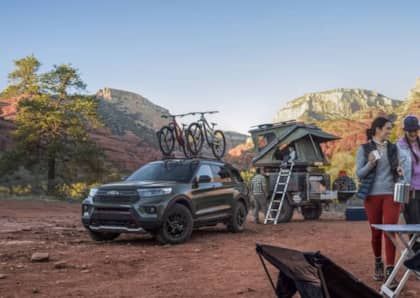4 Classic Truck Campers That You Didn't Know Existed
Long before the modern overlanding phenomenon became a popular form of recreation for off-roaders looking to spend a little extra time exploring the beauty of the natural world, Detroit's Big Three were looking to cash in on the camping craze that was sweeping the nation. Although camping trailers had been around for decades, by the mid-60s marketers hit upon the idea that families could drop a camping shell in the bed of a four-wheel drive pickup or SUV and begin to experience more remote corners of the national park system that had previous been out of reach of standard tow-in quarters.
This burst of factory fascination with the camping crowd would be brief, largely burning out by the end of the 1970s. During that decade and a half, however, a number of special model trucks would make it to market in a bid to court campers and convince them to join their compatriots in the wonders of off-road overnighting. Today, these vehicles are rare, as with any utility-focused vehicle from the era, but still pop up from time to time at shows and on auction sites to puzzle and delight collectors.
Chevrolet Blazer Chalet/GMC Jimmy Casa Grande
The Chevrolet Blazer Chalet and its corporate cousin, the GMC Jimmy Casa Grande, represented the peak of OEM involvement in camping. By replacing the fiberglass cover over the rear passenger compartment with a custom-fit camping shell, General Motors was able to create a unique camper for the 76-77 model years that offered short-wheelbase maneuverability, an open connection between the driver and the living area, and a relatively affordable purchase price (roughly $10,000 before options).

Chevrolet and GMC partnered with Chinook Mobilodge Inc., which manufactured the shell out of fiberglass and plastic. A pop-up top allowed a relatively low roofline when driving (reducing drag and improving mileage) combined with the ability to stand up straight inside the unit when parked (with almost six and a half feet of ceiling clearance).
The Chalet/Casa Grande offered five gallons of water storage, a kitchen outfitted with a sink and stove, a small table for eating, and, for those willing to spend a little more money, a fridge to replace the built-in cooler. Base models slept two, while four could be accommodated as an option (as long as the extra pair of adventurers were child-sized).

Less than 2,000 of the campers were ever built, and just over a third are thought to have survived the rough-and-tumble outdoor life.
Ford F-350 Super Camper Special
The Blue Oval's approach to building a camper was a little different, and considerably more long-lived. It began with taking the full-ton F-350 pickup it typically sold to farmers, industry, and those who needed to tow, and then increased the wheelbase by pushing the rear axle as close to the back bumper as possible.
The F-350 was a new model for 1973, which is when the Super Camper Special also first hit the market. The decision to preserve an eight-foot bed length paired with a 140 inch wheelbase created an unusual visual for anyone encountering an unladen version of this truck, but when equipped with the slide-in camper it was meant to lug around, it all made sense. It's worth noting that Ford had offered a Camper Special with its previous generation of F-250 trucks, but this model didn't feature nearly the same level of slide-in-specific customization.

Although ever-larger aftermarket campers were the reason Ford created this odd configuration, the company briefly provided its own Starcraft-built slide-in sleeper, which was sold during the first two years of production. Other goodies that came with the Super Camper Special (which lost the 'Super' appellation in 1977) included dual batteries, upgraded cooling and suspension, and a compartment carved into the side of the bed to house the spare tire relocated by the back axle push. The Camper Special would disappear completely after 1979.
Chevrolet Longhorn Custom Camper/GMC Custom Camper
Chevy beat Ford to the punch when it came to accommodating big slide-ins with the Longhorn Customer Camper, which was built on the full-ton C30 chassis. Offered in 1968, almost five years before the Super Camper Special appeared, it performed a different magic trick to handle increasingly large campers: an eight-foot box with an additional six-inches grafted onto it, riding on a 133 inch frame designed to accommodate a 9-foot stepside bed. The beds themselves were made of wood, and you could hang another two feet of camper from the back without breaking GM's official hauling guidelines.

GMC would also build a version of the truck simply called the Custom Camper. Just over 22,000 were built in the five year period between 1968 and 1972, all featuring similar hauling upgrades as compared to the Ford that would follow. General Motors advertised many different aftermarket campers in its brochures of the era, but it never included a factory-supplied slide-on of its own.
Dodge D Series Camper Special
Like Ford's early entreaties to the great outdoors, Dodge's first Camper Special wasn't all that…special. From 1966 to 1971, the vehicle took any of the pickup truck chassis you wanted—ranging from half-ton to full-ton, and of course the W200 4x4—and braced them to better handle the extra mass of a tote-along camper unit. Springs were stiffened, large side mirrors were added, the electrical system was upgraded, and the wheels were widened as part of the effort. You could also order Custom Camper and Deluxe Camper models if you wanted a little more luxury inside the truck.

The concept would continue for the next-generation D Series, which debuted for 1972. Dubbed the Adventurer Sport Camper 7500/9500 (referring to their gross vehicle weight rating), the models moved to the new platform while keeping the same type of weight-handling improvements in the mix.
Curious about modern overlanding? Check out our round-up of the essentials for this form of adventure camping.











